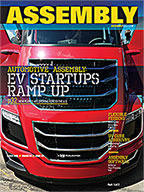A year ago, I wrote an article about General Electric Co.’s long history of producing locomotives. Since then, a lot sure has changed.
Once-proud GE is in a tailspin these days and is eager to sell or spin off some of its vast holdings. Many Wall Street analysts believe the GE Transportation unit will be the first to go.
The company also recently announced that it would cease production at its legendary manufacturing complex in Erie, PA. However, that move was not a complete shock. The factory’s demise has been rumored for several years—especially ever since GE Transportation opened a new state-of-the-art facility in Fort Worth, TX, in 2013.
And, to keep up with global demand, GE has invested in factories in Brazil and India. For instance, the company just unveiled a moving assembly line at its locomotive plant in Contagem, Brazil.
“Unlike traditional stationary production lines, the mixed-model line is designed for employees to assemble different locomotive configurations on the same line as the units slowly move down the track,” says Afonso Borges, industrial director at GE Transportation. “This new production system enables the plant to increase productivity and optimize the workforce, as well as reduce lead time and inventory.”
The assembly line moves between 1.15 to 2.20 meters per hour, depending on takt time. It cuts lead time by 20 percent, reduces inventory by $2 million and eliminates more than 10,000 square feet of space on the plant floor.
To address lean manufacturing initiatives, the new production system also provides real-time visibility to the various manufacturing stages. Borges says this “fosters a problem-solving culture among the employees to quickly resolve issues as they arise. This attribute makes the line ideal for digital monitoring.
"The mixed-model moving line was born connected,” adds Borges. “Several sensors have been installed to show the progress of all locomotive manufacturing steps, so delays, problems and other data are visible in real time through software developed to manage the line.
“The moving assembly line also means workers immediately flag any problems that arise,” explains Borges. “Issues are more visible now because they stop the line, so we are aware of them very fast. It helps us fix issues quickly, and it means we’re producing a higher-quality product because we know as soon as we have a problem.”
To see a video about the new moving assembly line, click here.










